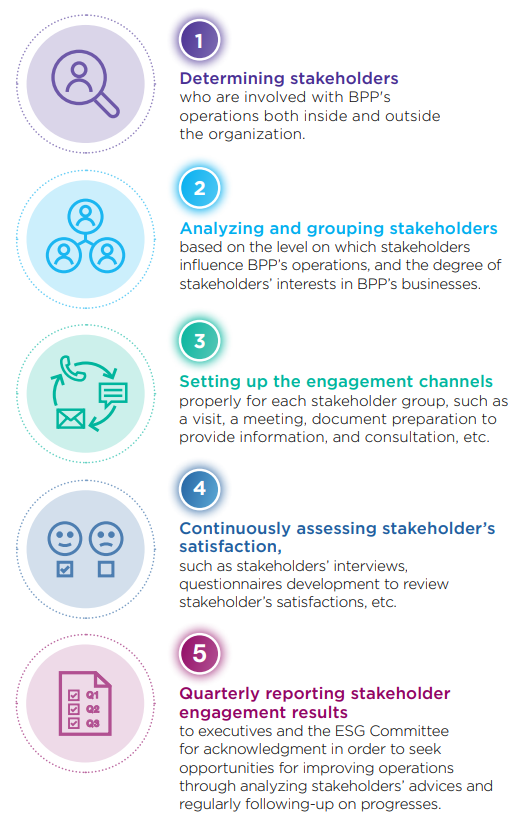1. Joint-venture
partners,
shareholders,
investors, and
financial institutions |
- Board meetings at subsidiaries and affiliated companies
- The Annual General Meeting of Shareholders
- Presenting information for investments in various agendas, such as the quarterly meetings, roadshows to present data and answer questions, etc.
- Arranging the security analyst meetings.
- Presenting corporate information at the “Opportunity Day” event organized by the Stock Exchange of Thailand.
- Creating various channels for receiving complaints, such as telephones and websites.
- The satisfactory survey’s questionnaires
- Annual reports
- Sustainable development reports
- Information disseminated on websites
- Participating in Carbon Disclosure Project (CDP).
- Taking part in Corporate Sustainability Assessment (CSA).
|
- Operating results, project development, and business growth
- Policies and financial data
- Operations responding to climate change
- ESG operations
- Risks management
- Auditing operation transparency
- Qualifications from the Board of Directors, executives, and remunerations
|
- Focusing on creating sustainability by investing in high-efficiency, low emissions power plants, such as gas-fired power plants, renewable energy and energy technology businesses, new businesses creating growth and reducing greenhouse gas (GHG) emissions, such as Carbon Capture, Utilization and Storage (CCUS), and energy storage systems, etc.
- Determining the Climate Change Policy and management approach, disclosing risks assessment data, impacts and operations related to climate change in accordance with the Task Force on Climate-related Financial Disclosures (TCFD).
- Setting a target for appropriate GHG emissions intensity responding to the gas-fired power plant business.
- Employing the risks management system in all business units.
- Implementing the internal audit covering all business units.
- Conducting the data accuracy assessment on ESG performance from external agencies.
- Taking part in Thai listed companies’ “Corporate Governance Reporting Project” for the year 2024, which was assessed by the Thai Institute of Directors (IOD), and receiving an excellent rating (five stars), including being a member of the Thai Private Sector Collective Action Against Corruption (CAC).
- Reviewing the Board of Directors’ qualifications to prepare the composition of the BOD’s knowledge and expertise or the skills matrix.
- Participating in the ESG Ratings, achieving recognition as a sustainable stock at the AAA level.
- Participating in the international sustainability assessment for the Electric Utilities industry, organized by S&P Global and FTSE Russell ESG Rating.
- Setting up the ESG Committee to govern and drive effective sustainability management.
|
| 2. Employees |
- The employee engagement survey
- The Banpu Heart corporate culture survey
- A welfare committee
- An occupational health and safety committee
- An innovation promotion committee
- Social responsibility activities
- A corporate culture promotion activity
- Employing performance assessment system.
- A meeting between senior management and employees
- Employee engagement promotion activities
- Dissemination of PR news within the organization
- Various grievance receiving channels, such as telephones, and websites
- Annual reports
- Sustainable development reports
- Information published on websites
|
- Business direction and corporate sustainable growth
- The corporate code of conduct and responsibility towards employees
- Fair remuneration
- A performance assessment system
- Career growth
- Employee’s competency development
- Being allowed to participate in making
decisions and have a chance for giving
opinions.
- Work-life balance
- Work environment and safety
|
- A two-way communication to create understanding and engagement among employees.
- Communicating about corporate governance and integrating CG as part of the organization’s culture
- Carrying out labor work as required by applicable laws and in accordance with the international principles.
- Determining clear, transparent, and fair key performance indicators (KPIs) for evaluating employees’ performance.
- Allocating budgets and courses to develop employee competencies and creating individual development plans.
- Cultivating a Banpu Heart corporate culture in all countries where BPP has operations.
- Regularly inspecting work environment and safety.
- Providing welfares to employees, such as an annual health check-up, “Flexi Hour”, “Flexi Benefits,” and “Work from Anywhere,” etc.
|
3. Government
sector |
- Arranging meetings and visits on various occasions.
- Site visits and operation inspections
- Submitting reports and data as required by applicable laws.
- Disclosing information as requested.
- Taking part in various projects organized by the government sector.
- Annual reports
- Sustainable development reports
- Information disseminated on websites
|
- Compliance with applicable laws and regulations, including mitigating risks properly.
- Upholding corporate governance in adherence to the Code of Conduct.
- Creating economic, social, and environmental values.
- Utilizing natural resources for maximum benefits.
|
- Establishing a legal register and keeping it up to date.
- Implementing a system to check and monitor legal compliance risks, especially a monthly inspection and
report, including an inspection from independent agencies.
- Announcement of the Corporate Governance Policy and the Code of Conduct principles and regularly
following up on CG operation performance.
- Carrying out corporate social responsibility projects, paying taxes as required by laws, and promoting local
employment and procurement.
- Giving cooperation and supporting the government’s sustainability projects.
- Executing environmental projects to reduce resource consumption and waste generation.
|
| 4. Customers |
- Customer’s satisfaction survey
- Conducting a forum to meet with customers in order to set plans, make understanding about the market situation and make a schedule for delivering work according to the targets set.
- Meeting with operators to exchange experiences in machine operation and contract management.
- Arranging customer visits to find out about the problems and find out solutions for improvement.
- Disclosing information as requested.
- Providing grievance/complaint channel through
telephones and websites.
|
- Delivering and developing products and services.
- Available factor of electricity and other forms of energy
- Business Continuity Management (BCM) to continue delivering products and services in the event of unexpected events
|
- Carrying out production and maintenance efficiently, able to maintain availability factor in supplying electricity and other forms of energy according to customer’s requirements with reasonable prices.
- Implementing a BCM plan to ensure the delivery of products and services during crisis.
- Surveying customer satisfaction and using the survey results to improve products and services.
|
5. Suppliers/
contractors |
- A supplier/contractor satisfaction survey
- A disclosure of procurement data through websites or applications
- A joint meeting with suppliers/contractors
- Organizing activities and training to build
suppliers’/contractors’ competencies and work safety.
|
- Transparent procurements and fair compensation
- Making payments in a specified period of time.
- Carrying out operations as specified in related project’s action plans.
- A safe working environment.
- Cooperation on creating and developing innovation to find market opportunities.
- Efficient joint-working procedures.
|
- Ensuring equitable disclosure of procurement information.
- Transparent procurement with fair selection criteria through the Supplier/Contractor Selection Committee.
- Communicating about operational plans and progress regularly.
- Specifying the environmental and workplace safety measures for contractors and those involved in operations equally to employees.
- Using the ESG criteria to assess suppliers’ performance.
- Communicating BPP’s Supplier Code of Conduct.
|
6. Communities
and society |
- Community satisfactory survey
- Social baseline surveys and gathering community’s opinions before project initiation.
- Meetings with communities
- The establishment of a joint-development committee with communities
- Creating community relations and co-organizing activities with communities.
- Site visits to learn about BPP’s operations
- Various grievance receiving channels, such as telephones and websites
- Annual reports
- Sustainable development reports
- Information dissemination on websites
|
- Community’s health and environmental
impacts management
- Human rights
- Social responsibility activities
|
- Deploying high efficient and low emissions technologies in project design and production processes
improvement.
- Employing an effective environmental management and monitoring system and using clean technology
with ultra-low emissions.
- Regularly communicating environmental performance to communities surrounding the power plants.
- Determining human rights policy and guidelines for assessing human rights related risks.
- Conducting human rights due diligence for businesses BPP has involved, such as BPP Office, power plants, and joint-venture power plants.
- Carrying out CSR projects to build competencies and sustainability for communities surrounding the power plants based on local needs, such as occupational promotion, providing knowledge for community members, etc.
- Giving assistance to communities and society, such as providing urgent assistance during the disasters, infrastructure development to improve quality of life for community members, etc.
|





